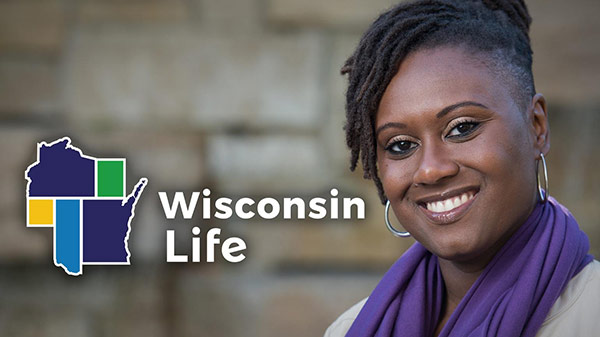If you could go back 900 or 1,000 years in time and walk through Jefferson County in southeastern Wisconsin, you would come across a thriving village of 500 or 600, with mixed cultures and trade routes connecting to far-flung places, a place that we know as Aztalan.
The goal of archaeologists and anthropologists today is, in some way, to bring back Aztalan, and that’s what host Norman Gilliland does during his conversation in University Place Presents Aztalan: A Place of Mystery with guest Sissel Schroeder, a professor of anthropology and archaeology and certificate advisor at the University of Wisconsin-Madison.
Norman Gilliland: I think a lot of us know about the site, Aztalan, as it is today. But put it in context for us in terms of as when Aztalan was thriving; What else was going on?
Sissel Schroeder: It was really sort of a thriving place mostly between AD 1100 and 1200, at a time when there were complex societies that had emerged across the southeastern United States.
These were different, almost like small political units, and Aztalan was one of them on the far reaches of the distribution of these societies across the southeastern U.S.
Many of its ties were with a site called Cahokia in Illinois, across the river from St. Louis, and we see some really key material similarities, as well as evidence, that some of the people who at least spent the early years of their lives, if not most of their lives in Cahokia came to Aztalan.
Gilliland: Who are the people we’re talking about in Cahokia and Aztalan?
Schroeder: We don’t know what they called themselves. We do know that both communities were multiethnic, that there were people who had come from different places and joined together in the St. Louis area and here in Wisconsin to create these settlements, these cities, if you will, that were occupied.
For Cahokia, there were maybe as many as 15,000 to 16,000. Aztalan was much smaller, on the order of perhaps 600 people living there. But people were more mobile than we think of them being today, and I think as family members might settle in a new place called Cahokia, other family members might follow them.
We know about the multiethnic nature of these communities because of the different styles of artifacts that they made, in particular pottery, that were very distinctive to certain regions and then came with them.
Gilliland: What kind of terrain are we talking about at Aztalan?
Schroeder: So Aztalan is situated along the west bank of the Crawfish River. It’s a somewhat sloping landscape with mounds on the high parts of the landscape that have been reconstructed. It just has this beautiful view into the valley of the Crawfish River.
It’s a different kind of landscape than we see at Cahokia, which is in the middle of a very broad, pretty flat floodplain. Early on, archaeologists thought that Aztalan’s location was a thing of curiosity. They wondered why it might have been placed in that particular location.
Gilliland: What conclusions did we draw?
Schroeder: Obviously, they had to have water, and they were right on the Crawfish River. It also appears that there was a spring there, and water was a very powerful cosmological material for the people from Cahokia and perhaps for the people that were living there locally as well, and so that might have also been something that was attractive.
Also, Cahokia was really a big place. It was a place that people made pilgrimages to, and it’s possible that some people from Wisconsin made a pilgrimage to Cahokia and then brought friends back with them to join them at the site.
Some people think that perhaps people from Cahokia were feeling disenchanted with their life at Cahokia and may have chosen to move north, looking for a better place to live, a better place for their families.
Gilliland: Some things never change.
Schroeder: Correct.
Gilliland: At what point do we find latter-day, which is to say European-origin archaeologists looking at Aztalan?
Schroeder: That starts in the 1800s, about 1830 I would say. As Milwaukee has been settled, people in Milwaukee begin to explore this land that is new to them — not new to the Native peoples in this area — and word gets out that there is a walled city some three-days journey from Milwaukee.
A man named Nathaniel Hyer undertook this journey and visited, and while he was there, he made a sketch map of the site that focused on what were the visible landscape features, in particular, a wall.
The wood of the palisade had already decayed, but all of the mud that had been coating this wall to make it a solid wall had kind of collapsed down. Some of it was sun-baked, and so there was this kind of high ridge that went around the entire community. It had little areas that jutted out, which matched with the bastions that were eventually excavated by archeologists.
He also mapped the locations of four mounds, one of which we now know is not a traditional mound in the sense of something that was built up over time. It was a consequence of a small natural landform that then had earth added to it that was then excavated into, and then added onto and excavated into, so really pretty complex.
As he was looking at one of the mounds — the mound that’s at the southwest corner of the site — he was struck by how it had multiple tiers to it.
He had been reading Baron Alexander von Humboldt’s “Travels Through Central and South America,” which was probably like a bestseller of the age. And he recollected that he had seen an engraving in that picture of a site called Cholula that had a stepped mound. Based on the engraving, he couldn’t know that that was a stone mound, and he knew he was looking at an earthen mound, but the appearance was so similar.
In the book, he noticed a passage that von Humboldt referenced that Cholula was an Aztec site, and the Aztecs’ ancestral home was considered to be someplace to the north. And somehow or another, von Humboldt got the idea that it was north of the 42nd parallel.
Gilliland: Which would mean Wisconsin.
Schroeder: Which would mean Wisconsin, exactly. And so, imagine in the early 1830s, and this young man is absolutely certain he’s found the ancestral home of the Aztec, and they call their ancestral home Aztalan, so he gave the site the name Aztalan.
Gilliland: Kind of jumped to a conclusion.
Schroeder: Jumped to a really big conclusion, but the name stuck. And so, you know, it’s just something that helped establish a myth that the site has a connection to Mexico.
Gilliland: It seems that a really big question still hangs over all of this though, Sissel, and that is, why did everybody leave?
Schroeder: That’s like a question that drives dissertation research and careers in archaeology. And it was probably a number of different factors that came together at the same time that had an impact on the people who lived at Aztalan.
We know from studies of lake bottom sediment cores from around the Midwest that there was a pretty geographically broad, significant — multi-year, maybe even multidecadal — drought that began probably right around AD 1200, and we don’t see a lot of evidence of people at Aztalan much after that time.
So that climatic situation may have been one factor. That drought, along with a massive flood that happened at Cahokia around maybe AD 1190, 1200, roughly speaking, may have really challenged leadership at Cahokia. And, Aztalan as a place with such strong connections to Cahokia, might have seen those connections wither, and that might have had an impact on the social and political situation at Aztalan at that time.
Also, there may have been conflicts that arose with other people that were moving into the area because of the drought that were being displaced from where they had been.
So there’s a lot of different things that could factor into this, some of which are testable that can really begin to get us a better image of what was going on.
Learn more from University Place and enjoy the full interview with Norman Gilliland and Sissel Schroeder by watching Aztalan: A Place of Mystery anytime at pbswisconsin.org or wherever you stream TV on the free PBS app.
 Passport
Passport





What do you think?
I would love to get your thoughts, suggestions, and questions in the comments below. Thanks for sharing!
Tara Lovdahl